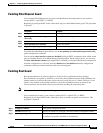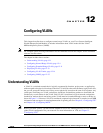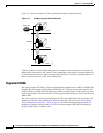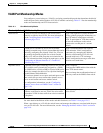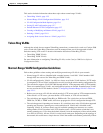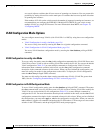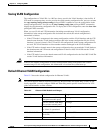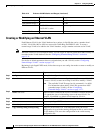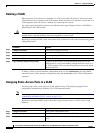
12-3
Cisco Systems Intelligent Gigabit Ethernet Switch Modules for the IBM BladeCenter, Software Configuration Guide
24R9746
Chapter 12 Configuring VLANs
Understanding VLANs
VLAN Port Membership Modes
You configure a port to belong to a VLAN by assigning a membership mode that determines the kind of
traffic the port carries and the number of VLANs to which it can belong. Table 12-1 lists the membership
modes and membership and VTP characteristics.
For more detailed definitions of the modes and their functions, see Table 12-4 on page 12-15.
When a port belongs to a VLAN, the switch learns and manages the addresses associated with the port
on a per-VLAN basis. For more information, see the “Managing the MAC Address Table” section on
page 4-18.
Table 12-1 Port Membership Modes
Membership Mode VLAN Membership Characteristics VTP Characteristics
Static-access A static-access port can belong to one VLAN and is
manually assigned to that VLAN. For more information,
see the “Assigning Static-Access Ports to a VLAN”
section on page 12-10.
VTP is not required. If you do not want
VTP to globally propagate information, set
the VTP mode to transparent to disable
VTP. To participate in VTP, there must be
at least one trunk port on the switch
connected to a trunk port of a second
switch.
A trunk port is a member of all VLANs by default,
including extended-range VLANs, but membership can be
limited by configuring the allowed-VLAN list. You can
also modify the pruning-eligible list to block flooded
traffic to VLANs on trunk ports that are included in the
list. For information about configuring trunk ports, see the
“Configuring an Ethernet Interface as a Trunk Port”
section on page 12-17.
VTP is recommended but not required.
VTP maintains VLAN configuration
consistency by managing the addition,
deletion, and renaming of VLANs on a
network-wide basis. VTP exchanges
VLAN configuration messages with other
switches over trunk links.
Dynamic access A dynamic-access port can belong to one VLAN (VLAN
ID 1 to 4094), and is dynamically assigned by a VMPS.
The VMPS can be a Catalyst 5000 or Catalyst 6500 series
switch, for example, but never a Cisco Systems Intelligent
Gigabit Ethernet Switch Module.
You can have dynamic-access ports and trunk ports on the
same switch, but you must connect the dynamic-access
port to an end station and not to another switch.
For configuration information, see the “Configuring
Dynamic Access Ports on VMPS Clients” section on
page 12-28.
VTP is required.
Configure the VMPS and the client with the
same VTP domain name.
You can change the reconfirmation interval
and retry count on the VMPS client switch.
Voice VLAN A voice VLAN port is an access port attached to a Cisco
IP Phone, configured to use one VLAN for voice traffic
and another VLAN for data traffic from a device attached
to the phone.
VTP is not required; it has no affect on
voice VLAN.





